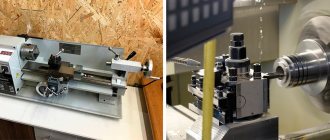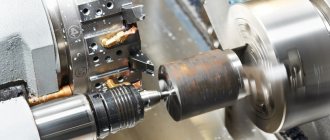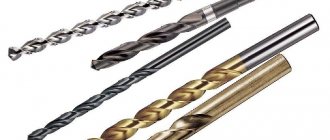The first patent for the creation of a bandsaw machine was received by the English engineer William Newberry in 1807, since then its concept has not undergone significant changes.
A saw in the form of a closed belt stretched on pulleys, one of which is a drive, is still the working part of any band saw machine. High cutting speed coupled with minimal dynamic loads makes a metal band saw an effective and sought-after piece of equipment. Such devices have advantages compared to circular saw (disc) cutting equipment. The latter, although it costs less, is in demand only in everyday life and in very small workshops - and even there, as the survey shows, they are thinking about replacing it. In this article we will talk about the operating principle, types and advantages of band machines.
Band saw for metal - what is it?
Currently, a great variety of band saw machines are produced: from the simplest manually controlled “cutters” to automatic machines capable of solving a wide variety of problems. With all this diversity, in accordance with the design of the saw frame, they are divided into four groups of equipment. The design and operating principle of metal band machines are described in the table:
| Types of metal band saws | Structural diagram | Functional | Note |
| Cantilever (pendular, cut-off) | Has an inclined saw frame, which, when lowered, cuts the workpiece | Cutting metal profiles and hollow parts (pipes up to Ø 300 mm, squares, etc.) | Can be swivel or fixed for sawing at right angles or at an angle of 45° |
| Horizontal (Single Post) | The horizontal saw frame moves along one vertical column, which is also called a stand | Cutting solid workpieces up to Ø 200 mm or hollow metal products | Prone to vibration and frequent saw blade breakage |
| Horizontal (two-column, two-post) | The saw frame resembles a cross beam, while the guide columns can have different profiles | Cutting solid workpieces up to Ø 500 mm | Can have a rotation angle range of 30° - 135°. |
| Horizontal (portal) | Two columns are additionally reinforced by a horizontal beam | Cutting large-sized metal structures (from 0.5 to 1.5 meters in diameter) | The saw can be installed to the working surface of the table at an angle of 3° |
| Vertical | The saw frame is stationary, the part is fixed on a movable table. For large machines, on the contrary, the saw frame moves along the table. | Longitudinal sawing of long workpieces | Capable of bevel cutting at angles up to 45°. |
Where are band sawing equipment used?
Band saw machines allow you to perform the following types of work and operations:
- sawing hard materials (rocks, wood, metal, etc.);
- cut workpieces of given sizes in the form of sheet materials, pipes, round rolled metal, corners, etc.;
- carry out work with materials of increased strength;
- separation into pieces and parts of food products in frozen form;
- for cutting and manufacturing workpieces with large overall dimensions or heavy weight.
Depending on where exactly the band saw will be used and how intensive the operation will be, all equipment on the market is divided into two large groups:
- industrial machines;
- household-grade equipment (for use at home, on personal plots, home mini-productions and workshops).
Industrial-grade machines are powerful production equipment, which is strictly divided into subtypes - for woodworking and for metalworking. Each subgroup presents a huge range of machine models, which may differ in technical characteristics and operational functions.
Household units are small in size, but their power and other technical parameters are also not as high as their industrial counterparts. It is assumed that the machines will not be used too often or very intensively.
Features and types of band saw machines
Cantilever band sawing machines are most in demand in metalworking, because on the one hand they are characterized by a wide range of applications, and on the other hand, they are easy to operate and affordable (from 20 thousand rubles). They can have either stepwise rotation of the saw frame, for example, 30°, 45° and 90°, or stepless rotation - in the range of 90°-30°. Typically, the frame lowers under its own weight, and the speed of sliding onto the workpiece can be adjusted by the operator using a damper cylinder.
Horizontal bandsaw machines can be either single-column, double-column, or reinforced with a transverse beam and having a powerful frame - portal. The machines of the first two types are small in size, the rigidity of the columns in them is sufficient. In portal saws, the saw frame moves up and down along a U-shaped structure. Depending on the purpose and functionality, they can have a rotating saw frame, and also be equipped with a mechanical vice or an integrated collet feeding system.
Vertical band saws are considered obsolete and, unlike horizontal ones, are practically not in demand, since when using them it is difficult to fix parts on the table and there is a high probability of injury. Nevertheless, there is a demand for them - they are needed, for example, for longitudinal cutting of long workpieces.
Purpose, characteristics and features of the equipment
The joiner's machine is equipped with a working tool in the form of a closed saw blade. It is tensioned by special wheels (pulleys, rollers, disks) and rotates continuously around them.
According to the codification current in the Soviet Union, carpentry bandsaw machines are vertical mechanisms with a saw blade of no more than 80 mm. The flexible saw allows you to make straight and curved cuts.
The band saw machine is used for the manufacture of a variety of products that are not regulated by precision. Based on the nature of the movement of the saw blade, such equipment is divided into devices with continuous and reciprocating motion. According to the method of feeding wood to the working body, they are divided into carpentry bandsaw machines with manual and automatic feed.
And according to the location of the bed stand of carpentry bandsaw devices relative to the wood being processed - left and right. Carpentry bandsaw machines with automatic wood feeding, unlike equipment with such an operation performed manually, are equipped with a special device for advancing. They have a roller design.
Carpentry bandsaw machines are used for their intended purpose in furniture, model making, packaging and a number of other industries. They are used where curved or straight sawing of wood is needed for workpieces (boards, fiberboard, chipboard, panels and other sheet materials). The band saw is used for work in carpentry, model, furniture and woodworking shops.
Band saw cutting principle
At large enterprises, machining centers and other modern equipment can easily cope with this task.
Main components of the design and structure It consists of the following elements:
- carpentry bandsaw machine bed (welded or cast);
- Desktop;
- fixed pulley (upper);
- lower drive disk;
- working body with guards;
- guide devices;
- brakes;
- electric motor;
- brush
Carpentry bandsaw machines in a simplified version look like this. A band saw with a guide and guard, a brake and a tilting table is installed on the vertical frame. There are also non-driven upper and driven lower disks supporting the saw blade here. The rotation of the latter is performed by an electric motor through a mechanical transmission.
Installation of the canvas
Wood band saw
Band saws have dimensions in width (10 to 50 mm). Thickness varies from 0.4 to 0.8 mm. These dimensions depend on the type of intended work and the dimensions of the machines. They are mounted on the upper and lower disks; depending on the brand of equipment, their diameter ranges from 400 to 800 mm. To obtain a closed ring of saw tape, the ends are soldered with copper or brass.
In this case, the rigidity of the soldering area must correspond to the parameters of the rest of the fabric. Adjusting the tension of saws on carpentry machines is carried out in a special way (by moving the upper wheel), and elongation during operation when heated is compensated by an installed spring. Most of the saw blade, except for the working part, is located in a protective housing.
The pulleys are mounted on a shaft; they have a soft leather or rubber bandage; sometimes the surface is covered with rollers made of cork wood. This protection not only serves to protect the teeth of the saw blade from damage, but also guarantees reliable grip when the wheel and working element rotate. The band saw machine has brakes and mechanical saw band catchers that are triggered when it breaks.
Italian vertical band saw MD Dario Set 3000 SV3 MAXI
Sawing with MD Dario Set 3000 SV3 MAXI
Most of them are equipped with brushes for cleaning and blowing from above the processed wood and suctioning chips and dust into special receivers located in the lower part of the frame. Guide devices (rollers, bosses), made of anti-friction material, prevent the saw from moving sideways and sliding off the guide disk.
To increase labor safety, carpentry bandsaw machines are equipped with a locking device, which prevents work on faulty equipment.
To install the working body of band saw devices, fences are opened. Carpentry bandsaw machines must be adjusted for safe and trouble-free operation. For this purpose, the upper pulley is lowered down and adjusted so that both disks are in the same vertical plane.
The machine is made in such a way that the frame in the upper half is L-shaped, in which the upper pulley is located. This product is subjected to heat treatment to eliminate internal stresses, which avoids deformation during operation. Carpentry bandsaw machines are equipped with a cast or welded table, which is made of steel, cast iron or aluminum. It has two working positions: horizontal and inclined (up to 45 degrees).
There is a slot on the surface for the movement of band saw blades, and grooves for installing guide rulers. The surface of the table top of some band saws is electroplated.
Classification of band saw machines
Class 1 - Class 1 band saw machines are designed for sawing difficult-to-process materials, including non-ferrous alloys, structural and high-alloy steels, nickel and titanium alloys. They are characterized by great power.
Class 2 - Class 2 band saw machines are used for cutting metals and alloys with bimetallic band saws - including non-ferrous metals, alloy and stainless steel, heat-resistant steel, easy-to-process titanium alloys.
Class 3 - Class 3 band saws are designed for cutting pipes and profiles, although they can also be used for sawing solid products. Characterized by low productivity.
Class 4 - Class 4 band saws are not intended for production purposes, but can be used in workshops for cutting steel sheets up to 1 mm thick.
Features of work when sawing
When operating such equipment, sawing is performed with the tensioned part of the blade along the path between the work table and the rollers of the guide device when moving downward. Before starting work, the saw needs to be idle for 30 minutes. drive around the entire circle, this will give time to work with the guide discs and control the heating of the belt.
Before purchasing equipment, be sure to calculate the volume of future work, the required performance and reliability. After all, the success of your business will depend on the right choice of equipment.
After such a procedure, you can quickly react to changes in load and prevent overheating and, accordingly, subsequent breakage of the web. Control over the cleanliness of the disk is no less important, since contamination will lead to the tape coming off the guide wheel and breaking. In addition, the moving parts of the belt machines are lubricated, and the bearings also need temperature control.
A straight saw of a workpiece is possible using a guide ruler or using a mobile cross stop. The production of straight parts in large quantities makes it possible to mechanize the supply of wood for machines, and even automate the process. This can be done through the use of a removable feeding device (automatic feeder).
It is based on a rotating bracket with installed drive rollers having a grooved surface. When turning this device, the latter presses the wooden workpiece against a vertical ruler, then feeds it to the saw blade.
Curved sawing
The band saw machine is used for cutting curved workpieces; it is popular in model making, carpentry, and among furniture makers.
This is explained by the fact that small enterprises are not able to purchase expensive modern equipment for a number of reasons, so carpentry bandsaw machines are a lifesaver for them.
And as a result, the use of small-sized tape machines of this type is in steady demand. Woodworkers know that automatic feeders are rarely used when making shaped pieces.
Classification by control system
Based on the control system, machines are divided into:
- Manual . Manually operated band saws are designed for cutting metal in small-scale production. As a rule, these are cantilever or single-column machines in which the saw frame is lowered by the worker - in this case, automatic return is not provided. They have a budget price tag.
- Semi-automatic devices . The semi-automatic band saw machine is equipped with an automatic system for lowering the saw frame, has a mechanism for auto-return of the frame at the end of cutting and is equipped with a hydraulic vice for fastening. The worker only feeds the workpiece under the saw blade; the machine does the rest.
- Automata . Automatic metal band sawing machines have the highest degree of automation, that is, they can operate without an operator. They are capable of clamping workpieces, cutting and removing finished products without the participation of a worker at all. Such equipment is very expensive and is intended for assembly line production. The machines are required to be equipped with:
- high-precision rotation angle sensors;
- saw frame height sensors;
- sawing pressure indicators;
- rotation speed sensors, belt break indicators on the pulley;
- interface for connecting to external control via the Industrial Internet of Things.
Advantages of cutting on belt-type machines
Regardless of the cutting methods and equipment used, manufacturers have to leave large allowances for the next processing of workpieces. This is due to the inability to ensure high accuracy of preparatory operations. As a result, the machining process becomes more complicated and more expensive.
Today, metal blanks are cut in different ways:
- using cutters (disc plates), which are fixed on circular saw equipment;
- using cutters or special cutters mounted on cutting devices;
- using hacksaw mechanical devices;
- using an abrasive cutting tool;
- when using a cutting band blade that is installed on the machine;
Cutting metal workpieces has many advantages . Among them:
- maximum work productivity;
- the ability to perform cutting with increased accuracy;
- the ability to obtain more accurate cuts;
- insignificant metal consumption due to the small width of the cut;
- ability to change the cutting angle;
- versatility;
- the ability to cut workpieces collected in packages;
If you intend to purchase a band saw for your workshop, pay attention to a number of required characteristics. Among them are the depth and width of the cut . This figure varies between 80−360 mm and 230−610 mm, respectively. Also take into account the speed adjustment, which is necessary to accurately set operating modes. In turn, the tilt of the table allows for precise cutting at a certain angle. The speed of the web and the power of the device are also important indicators.
To avoid mistakes in choosing the right machine, carefully weigh all the details, and also consult with a specialist. In this case, your purchase will be as successful as possible.
Read reviews
If in a large enterprise the choice of equipment is carried out by specialized specialists, then in a small and medium-sized business the entrepreneur has to rely solely on himself. You don’t really have to trust the consultants from the selling companies, since they are interested in selling their tape machines. In order to choose the equipment correctly, you should carefully study the characteristics of the metal band saw. Often in small industries, metal cutting is done manually using ordinary grinders. Meanwhile, the use of band saws makes it possible to achieve high-quality cuts, with virtually no metal shavings.
Metal processing specialists advise paying attention to Russian equipment, since there are specialized services that will help you quickly find the reasons for poor machine performance, for example, when the material supply is not adjusted or the drive mechanism is “capricious”, breaking the blade. The most valuable information when choosing equipment is reviews on specialized forums, telling, for example, how to use German spare parts to significantly increase the reliability of Chinese metal band machines.
Principle of operation
As mentioned above, the key cutting element of such machines is a belt, which is pulled over two flywheels. This element starts working immediately after turning on the machine. Once this happens, cutting can begin.
The device is designed in such a way that when performing a task, the pressure on the workpiece becomes uniform. This feature allows you to make precise cuts. In addition, cutting with a band saw is performed both perpendicularly and at an angle of up to 60 degrees. To get a cut at an angle, it is enough to change the position of the blade or rotate the movable frame where it is fixed. You can also try the desktop rotation method.
During operation, the cutting blade overheats greatly, which increases the likelihood of its breakage. To protect the structure from such consequences, it is enough to apply a cutting fluid to the cut site, which can protect the working blade from rapid wear, as well as protect the surrounding air from metal dust or sawdust. As such a means, ordinary water or a special composition is used, which guarantees complete cooling of the equipment and lubrication.
Some manufacturers install special brushes on their models that automatically clean the working surface of all residues in the form of chips and dust. This simple solution allows you to achieve a smoother cut, as well as increase the service life of the device and provide the operator with reliable protection .
The band saw machine has different types of saws:
- Carbon steel. Designed for processing alloyed and unalloyed alloys;
- From bimetallic alloys. Necessary when using special cutting modes;
- Made from carbide materials. This solution is indispensable for cutting metals that are difficult to process. We are talking about cast iron, alloys with a high titanium or nickel content;
- Diamond coated. Such models are suitable for processing abrasive raw materials;
Examples of choosing machines for small and medium-sized businesses
The Anchor Corvette 422 cantilever machine is designed for small-scale work; it has a rotary vice, but is equipped with a coolant supply system. The console Proma PPS-270THP is capable of sawing at any angle chosen by the operator.
The two-column semi-automatic machine Fmb OLIMPUS 3+VHZ is designed for simultaneous sawing of several rolled products; it can cut large-sized workpieces made of steel of all grades, albeit with low productivity.
What brands are most in demand today:
Machine Tool Manufacturers
The production of equipment of this type is carried out in several stages. Initially, sketches are made, including components and parts. These are used to subsequently produce units. Closed profiles are used to make the frame. They can have different sizes, which are directly affected by the dimensions of the components and parts. Most often, woodworking machines are made from U-shaped profiles.
The manufacturer initially makes the base of the machine. For this purpose, sheet steel is usually used, the thickness of which is 4 millimeters. The frame must be properly attached to the base. Next, the desktop is processed. To do this, a sleeve is welded for the axes of the support bracket. Ball bearings are characterized by the presence of an axis into which the lower disk is screwed. The upper disk is installed on ball bearings. The axle is fastened with a special bracket, with the help of which the angle of inclination is changed.
The manufacturer attaches the supporting frame with bolts or nuts and guides are placed on it. A guard is attached to the front of the machine. Screws are often used for this purpose. For the highest quality movement of the workpiece on the table, it is made from textolite. The pulley is secured using screws or a pin. Installation of the lower and upper disks is carried out with a divorce.
The production of band saw machines is carried out according to a strictly established scheme. This ensures the long life of the band saw.
The body of the unit is characterized by the presence of a paint and varnish coating, which protects it from corrosion. High-quality materials are used to produce the machine, which guarantees not only excellent performance, but also a long service life.
The main brands found on the market today are Jet, Proma, Altesa, Makita, Metabo, Holzstar and others.
What to pay attention to
Replacing wear parts can cause a lot of inconvenience, so when purchasing, be sure to find out the service life of carbon brushes, drive belts, guides and feed rubber rollers, bearings, and toothed belts. And also are there any reliable analogues from German or Japanese manufacturers.
The cause of premature failure of band saw machines is mechanical damage due to worker negligence. In addition, reliability is negatively affected by:
- high humidity;
- aggressive environments;
- internal or external contamination of equipment;
- deliberate violation of operating instructions, for example, to increase productivity;
- power surges;
- foreign objects entering the saw frame - for example, sand, stones, insects;
- design changes;
- violation of the rules of lubrication and coolant cooling.
Range of application of band saws
Band saws are usually used for cutting rolled metal:
- Pipes
- Channel
- Corner
- Cylinders
- Hexagons
- etc.
Band saws have found unusually widespread use in machine-building enterprises . Band saws are used to cut metal castings prior to turning. They are used in metal assembly shops and on repair sites.
At their core, band saws are indispensable in cases where metal needs to be cut quickly, accurately and accurately.
Now let’s learn more about the types of band saw machines.
Specifications
Key parameters to consider when choosing a band saw:
- power: a household unit has enough power of 500 - 750 W, industrial units can be up to 3 kW;
- mains voltage: household models operate from 220 V, industrial models from three-phase 380 V;
- cutting depth: the weakest machines can handle boards up to 15 cm thick, industrial ones - up to 1 meter;
- cutting width: the maximum cutting width is determined by the distance from the tape to the stand. Minimum distance 350 mm, sufficient for working with small parts;
- the speed of movement of the belt or cut is measured in meters per minute and can be from 200 to 1250. The higher the speed, the cleaner the wood is cut. For hard rocks the speed is slightly reduced;
- dimensions of the working surface;
- saw blade length;
- mechanism weight.










